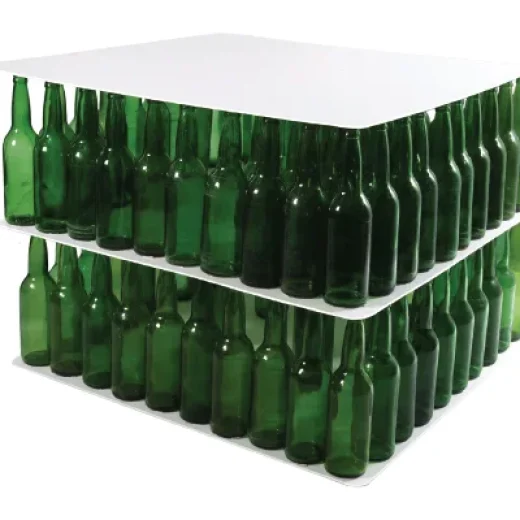In the world of industry and logistics, maintaining product safety and integrity during storage is a top priority.
Often, the solution to prevent damage and improve stacking stability comes from a simple yet often overlooked component — the pallet pad.
Serving as a protective layer placed on top of pallets, pallet pads create a flat surface to support goods, protect products from damage, and optimize organization and efficiency throughout the warehouse area.
What Are Pallets and Pallet Pads?
A pallet is a flat structure used as a base to stack, store, and move large quantities of goods.
Pallets are designed to be lifted and transported easily using forklifts, hand pallets, or conveyor systems — allowing multiple individual loads to be integrated into one manageable unit.
Meanwhile, a pallet pad (also called a separator sheet or layer pad) is a protective sheet placed between each layer of goods stacked on a pallet.
Its main function is to prevent friction, protect product surfaces, and maintain stacking stability so that items don’t shift or collapse. Pallet pads are essential when stacking boxes or packaging with smooth surfaces.
Materials and Main Applications
Pallet pads are typically made from high-quality plastics such as High-Density Polyethylene (HDPE) or Polypropylene Board (PP Board).
These materials are chosen for their strength, impact resistance, moisture resistance, and durability. The combination of pallets and pallet pads is widely used in various sectors — from warehouses and manufacturing plants to major distribution centers.
Advantages of Using Pallets and Pallet Pads
Choosing a reliable pallet and pallet pad supplier provides several operational benefits for your business, including:
1. Improved Product Stability
Using pallet pads between stacked layers of cartons or boxes greatly enhances load cohesion.
This is especially helpful when goods are stacked high on warehouse racks or subjected to movement during transport. Stable stacks reduce the risk of accidents and product damage.
2. Long-Lasting and Heavy-Duty Strength
Plastic pallet pads, especially those made from PP Board, are designed to support heavy loads. The material is resistant to wear, cracking, and corrosion — making it a cost-effective long-term solution.
3. Easy to Use and Practical
Both pallets and pallet pads are built for daily warehouse efficiency.
Pallets come in standardized sizes compatible with forklifts, while pallet pads can be quickly placed between product layers. This simplicity accelerates loading, unloading, and stock retrieval processes.
4. Water-Resistant and Chemical-Resistant
One major benefit of PP plastic pallet pads is their resistance to moisture, water, and mild chemicals.
They are ideal for industries that prioritize hygiene and sanitation, such as food, beverage, and pharmaceutical manufacturing. Additionally, PP pallet pads are easy to clean with water.
5. Maximized Warehouse Efficiency
By using pallets and pallet pads of uniform size, warehouse layouts become more organized and space-efficient.
Storage areas look tidier, easier to manage, and capable of vertical stacking for maximum space utilization. This efficiency helps save time when locating or moving goods.
Applications of Pallets and Pallet Pads
Industrial pallets and pallet pads are used across almost every sector that involves product storage, including:
- Warehousing & General Industry: For stacking cartons, boxes, finished products, and raw materials on racks or staging areas.
- Industrial Spare Parts Storage: Keeps machine parts and components safe from dust, moisture, and impact.
- Internal Transport & Distribution: Provides a stable base for transferring goods from production lines to warehouses or distribution centers.
- Food, Beverage, and Pharmaceutical Industries: Ensures stable stacking of bottles or cans while protecting against contamination.
Tips for Choosing the Best Pallet Pad Supplier
To get maximum benefits, consider these factors before purchasing:
1. Prioritize Material Quality
PP Board pallet pads are the best choice today due to their strength, impact resistance, and long service life. Avoid materials that are too thin or easily torn.
2. Match Size with Pallet and Rack Dimensions
Ensure your pallet pad dimensions align with your pallets and warehouse racking system. Incorrect sizing can reduce stacking stability and efficiency.
3. Choose Anti-Slip Surface Options
Select pallet pads with textured or anti-slip surfaces for extra grip. This feature minimizes the risk of products shifting or falling during handling.
4. Find a Supplier Offering Custom Options
Choose a supplier that provides customization services—size, thickness, and color—to meet your specific operational needs.
Custom options ensure you get the most effective pallet pad for your warehouse and product type.
Upgrade Your Warehouse Efficiency with PP Board Layer Pads from ALVAboard!
ALVAboard PP Board Layer Pads are high-quality polypropylene (PP) flat sheets designed as separators between products stacked on pallets.
They are the perfect alternative to thin cardboard sheets that easily break or absorb moisture.
PP material offers superior strength, water resistance, and reusability, providing optimal protection for every product layer in your pallets.
No more damaged packaging caused by damp or crushed separators — ALVAboard Layer Pads keep your goods protected from the warehouse to final delivery.
Want to learn more about ALVAboard Layer Pads? Contact our team today and consult your layer pad needs for your business!


